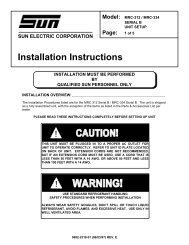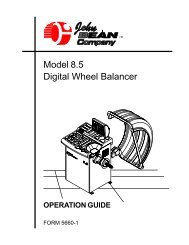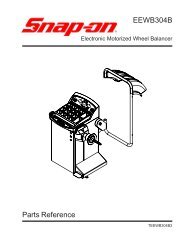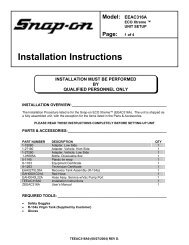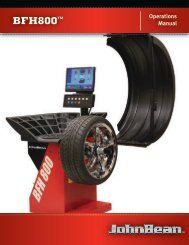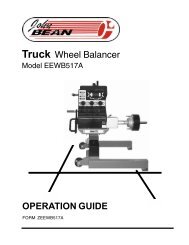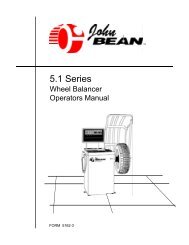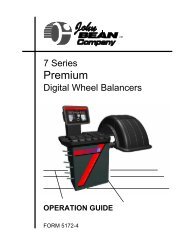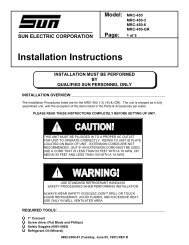Operating Instructions - Snap-on Equipment
Operating Instructions - Snap-on Equipment
Operating Instructions - Snap-on Equipment
You also want an ePaper? Increase the reach of your titles
YUMPU automatically turns print PDFs into web optimized ePapers that Google loves.
Interpretati<strong>on</strong>Discussi<strong>on</strong>Under certain c<strong>on</strong>diti<strong>on</strong>s, the analyzer adds a diluti<strong>on</strong> correcti<strong>on</strong> factor (DCF) tothe measured HC, CO, and NO values. This means the gas values reported in thetest results are greater than the gas values measured by the analyzer. The DCFwas developed by the State of California in 1994 to correct measured gas valuesfor exhaust system leaks.Select DCF OFF to see the measured gas values and select DCF ON to see thereported values. The DFC applied range is from 1.0 to 3.0. If the factor required is lessthan 1.0 or more than 3.0, the analyzer uses 1.0, which has no effect <strong>on</strong> gas values.Examples:measured gas x DCF = reported gas220 HC x 2.5 DCF = 550 PPM HC220 HC x 1.0 DCF = 220 PPM HC✓ Actual state I/M programs use:— DCF for Idle Test.— Both DCF and HCF for ASM Tests.Humidity Correcti<strong>on</strong> FactorsWhen using the Humidity Correcti<strong>on</strong> Factor (HCF) to report I/M results, select aHCF preference by choosing HCF ON or OFF.Specificati<strong>on</strong>sApplicati<strong>on</strong>:Purpose:Gas Value Affected:Affect:Factor Range: 0.739 – 2.52Temperature Range: 32 °F – 86 °FHumidity Range: 1% – 100%Barometric Pressure Range: 28.00" – 32.00" HgDiscussi<strong>on</strong>Certain test resultsCorrects for water c<strong>on</strong>tent of the ambient airNOHCF may increase or decrease gas valuesUnder certain c<strong>on</strong>diti<strong>on</strong>s, the analyzer adjusts the measured NO (NO x ) value with ahumidity correcti<strong>on</strong> factor (HCF). This means that NO value reported with results maybe less or greater than NO values measured by the analyzer. Depending <strong>on</strong> currenttemperature, humidity, and barometric pressure c<strong>on</strong>diti<strong>on</strong>s, the HCF may increase ordecrease the measured NO value. The EPA developed the HCF to compensate forrelative ambient humidity. The HCF is not applied during vehicle diagnosis.The HCF factor ranges from 0.739 to 2.52. The factor is applied over a widerange of temperatures (32 °F to 86 °F), humidities (1% to 100%), and pressures(28.00" to 32.00" Hg).Examples:measured NO x HCF = reported NO1500 ppm NO x 0.948 HCF = 1422 ppm NO1500 ppm NO x 2.03 HCF = 3045 ppm NOUsing Correcti<strong>on</strong> Factors (DCF and HCF) for RepairUse this simple, effective repair strategy to avoid any c<strong>on</strong>fusi<strong>on</strong> based <strong>on</strong>correcti<strong>on</strong> factors.1. Pretest the vehicle with the analyzer program to obtain “baseline”emissi<strong>on</strong>s data.5-4



